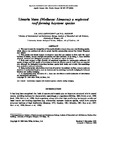Limaria hians (Mollusca: Limacea): a neglected reef-forming keystone species
| dc.contributor.author | Hall-Spencer, Jason | |
| dc.contributor.author | Moore, PG | |
| dc.date.accessioned | 2013-02-20T12:20:09Z | |
| dc.date.available | 2013-02-20T12:20:09Z | |
| dc.date.issued | 2000-07-17 | |
| dc.identifier.issn | 1052-7613 | |
| dc.identifier.issn | 1099-0755 | |
| dc.identifier.uri | http://hdl.handle.net/10026.1/1363 | |
| dc.description.abstract |
1. The case is made for recognition of the marine bivalve Limaria hians as a reef-forming species, which plays a key architectural role in certain benthic communities around the United Kingdom and Ireland. 2. This species uses byssal threads to construct nests that can coalesce to form reefs that cover hectares of seabed, contain multiple conspecifics and bind sediment. In so doing, L. hians modifies physical, chemical and biological processes at the sediment–water interface. 3. Such nests support a high diversity of associated organisms in coarse-grade sediments (19 species of algae and 265 species of invertebrates from six discrete nests in Loch Fyne are reported on), although the biological interactions between species both inside and outside this assemblage (e.g. predatory cod) are unknown. 4. Being insubstantial, labyrinthine structures situated on the sediment surface, Limaria nests are sensitive to mechanical impacts, such as those caused by moorings, hydraulic dredging for infaunal bivalves and scallop dredging. 5. At appropriate sites, the status of L. hians can contribute a useful indication of disturbance on coarse-grade sediments. Copyright © 2000 John Wiley & Sons, Ltd. | |
| dc.format.extent | 267-277 | |
| dc.language | en | |
| dc.language.iso | en | |
| dc.publisher | Wiley | |
| dc.subject | biodiversity | |
| dc.subject | biogenic reef | |
| dc.subject | keystone species | |
| dc.subject | Limaria | |
| dc.subject | scallop dredging | |
| dc.title | Limaria hians (Mollusca: Limacea): a neglected reef-forming keystone species | |
| dc.type | journal-article | |
| plymouth.author-url | https://www.webofscience.com/api/gateway?GWVersion=2&SrcApp=PARTNER_APP&SrcAuth=LinksAMR&KeyUT=WOS:000088566200003&DestLinkType=FullRecord&DestApp=ALL_WOS&UsrCustomerID=11bb513d99f797142bcfeffcc58ea008 | |
| plymouth.issue | 4 | |
| plymouth.volume | 10 | |
| plymouth.publication-status | Published | |
| plymouth.journal | Aquatic Conservation: Marine and Freshwater Ecosystems | |
| dc.identifier.doi | 10.1002/1099-0755(200007/08)10:4<267::aid-aqc407>3.0.co;2-b | |
| plymouth.organisational-group | /Plymouth | |
| plymouth.organisational-group | /Plymouth/Faculty of Science and Engineering | |
| plymouth.organisational-group | /Plymouth/Faculty of Science and Engineering/School of Biological and Marine Sciences | |
| plymouth.organisational-group | /Plymouth/PRIMaRE Publications | |
| plymouth.organisational-group | /Plymouth/REF 2021 Researchers by UoA | |
| plymouth.organisational-group | /Plymouth/REF 2021 Researchers by UoA/UoA07 Earth Systems and Environmental Sciences | |
| plymouth.organisational-group | /Plymouth/Research Groups | |
| plymouth.organisational-group | /Plymouth/Research Groups/Marine Institute | |
| plymouth.organisational-group | /Plymouth/Users by role | |
| plymouth.organisational-group | /Plymouth/Users by role/Academics | |
| dcterms.dateAccepted | 2000-02-06 | |
| dc.identifier.eissn | 1099-0755 | |
| dc.rights.embargoperiod | Not known | |
| rioxxterms.versionofrecord | 10.1002/1099-0755(200007/08)10:4<267::aid-aqc407>3.0.co;2-b | |
| rioxxterms.licenseref.uri | http://www.rioxx.net/licenses/all-rights-reserved | |
| rioxxterms.type | Journal Article/Review |


